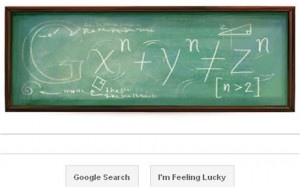Pierre de Fermat’s 410th birthday
Fermat’s Last Theorem was the best known work of Pierre de Fermat, a 17th Century French lawyer and an amateur mathematician who is given credit for early developments that led to infinitesimal calculus.
His 410th birthday is marked today with a Google doodle, partially, illustrating his theory with the principal equation written in chalk on a blackboard with a partially erased Google logo.
There is also an appropriation of his famous words and notes in the alt text of the Google doodle that reads: “I have discovered a truly marvelous proof of this theorem, which this doodle is too small to contain.”
Believed to have studied law Toulouse and Bordeaux, Pierre de Fermat was born on August 17 (1601) and died January 12 (1665).
Described in a note at the margin of a copy of Diophantus’ Arithmetica in 1637, Fermat’s Last Theorem states that no three positive integers a, b, and c can satisfy the equation ‘an + bn = cn’ for any integer value of n greater than two, as long as a, b, and c are not equal.
Fermat famously claimed that he could prove the hypothesis but that it was too large to fit in the margin – an approach that enterprising pupils have claimed in maths lessons ever since.
The Doodle shows a blackboard with algebraic symbols on it, with the word ‘Google’ faintly visible as though rubbed out earlier. The symbols read: ‘xn + yn ≠ zn’. If you hover your mouse over the Doodle, the pop-up text reads “I have discovered a truly marvelous proof of this theorem, which this doodle is too small to contain.”
Pierre de Fermat, was born on 17 August 1601, 410 years ago. A lawyer at the Parlement of Toulouse and a gifted amateur mathematician, he made breakthroughs in several fields of calculus, probability, geometry and number theory, but is best known for a brief note he made in the margin of a book of arithmetic.
His enigmatic aside set the scene for perhaps the greatest mathematical mystery of all time.
It had been known for centuries that ‘a2+ b2 = c2′. That is, any ‘square’ number – the product of a whole number multiplied by itself – added to another square, created a third square.
However, it had been the subject of argument whether that held true for any other power – or, as mathematicians would put it, whether there was any n for which an + bn = cn. Many believed it was not, but no-one could prove it mathematically.
Around 1637, Fermat wrote of this problem, in the margin of Arithmetica by the Greek mathematician Diophantus – “I have discovered a truly marvelous proof of this, which this margin is too narrow to contain.” However, he never wrote out what that proof was, despite living for another 30 years. This led many people to believe that he had never, in fact, proved it.
In 1993, more than 300 years after Fermat’s death, Andrew Wiles, a professor of mathematics at Oxford University who had been obsessed with the ‘Last Theorem’ since he was 10 years old, put forward a proof of the conjecture. However, it was shown to be incomplete. It was not until 1995 that he finally managed to finalise the proof, and show that as Fermat said: ‘an + bn = cn’ was only true when n=2. Far from being a simple proof, his paper was more than 100 pages long: certainly too long for a margin.
“I have discovered a truly remarkable proof but this margin is too small to contain it” – Pierre de Fermat famously wrote on the margin of his copy of the Arithmetica by Diophantus of Alexandria back in 1637. The proof the French mathematician and lawyer was referring to was for his theorem in which he states that no three positive integers x, y, and z can satisfy the equation ‘xn + yn = zn’ where n is an integer greater than 2. Fermat’s Last Theorem, also called Fermat’s great theorem, was his best known work and to commemorate the 410th birth anniversary of the founder of the modern theory of numbers Google has put up a doodle inspired by it. Instead of a copy of the Arithmetica, the Google doodle uses a blackboard with a faintly erased Google logo and the theorem written in chalk.
Google also does a little spin-off on Fermat’s famous words and notes in the alt text of the doodle (that is readable when a user hovers the cursor over the image) “I have discovered a truly marvelous proof of this theorem, which this doodle is too small to contain.”
Pierre de Fermat was born on August 17, 1601. His father was a wealthy French businessman. There is little information about his early education, but he is believed to have studied law at Toulouse and Bordeaux. He developed an interest in languages, literature, science and mathematics. After receiving a degree in law from the University of Orleans in 1631 he started his legal career and a few years later changed his name from Pierre Fermat to Pierre de Fermat.
Because Fermat did not spread his work through books and journals and he often did not provide any proof for his theorems he was referred to as an “amateur” mathematician, but at the same time Fermet is also considered to be one of the two – the other being Rene Descartes – leading mathematicians of the first half of the 17th century.
Pierre de Fermat died at the age of 63 on January 12, 1665 at Castres, France.
